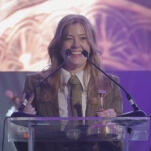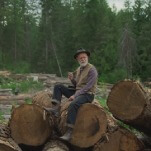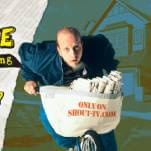The San Diego Comic-Con has been dubbed the “nerd prom,” largely because the event is often the highlight of the year for those focused on geekier pursuits. Yet after three years here—and upon entering my fourth—I’m not sure that moniker has it exactly correct. “Nerd prom” suggests the culmination of something, the idea that everything has been building toward this, and once it’s over, something new will have to begin. But Comic-Con is pretty generally a chance for Hollywood, comics companies, and ball-jointed doll enthusiasts to get fans excited about what’s coming down the pipe. No, Comic-Con is the Nerd State Fair.
This reference might not make a lot of sense, because state fairs are on the way out, but the events are scarily similar. State fairs began as gathering places for farmers as the summer waned and harvest drew near, and they still maintain those agricultural roots, with places for farmers to check out the newest equipment, demonstrations of various farming techniques, and carnival rides. (Okay, that last one has very little to do with farming.) A state fair is a massive expo, designed to get people talking about the latest gear and to bring people together who will only see each other once a year. I should hope that would sound familiar.
But Comic-Con is also something of a Nerd Political Convention, with the friendly rivalry between DC and Marvel standing in for the not-so-friendly rivalry between Republicans and Democrats. Everything’s scripted within an inch of its life, and the attendees are easily supplicated with the promise of free things. The whole event is designed to placate the faithful, and delegates travel from all over the world to stump for the things they truly love. And yet when the whole thing is over, it leaves a distinct taste of artificiality in the mouth. There’s very little that’s real about it. It’s a carefully stage-managed event designed to put fans in close proximity to the things they’re fans of, while allowing for maximum opportunity to control the narrative sent out by the press. Naturally, of course, all of us in the entertainment press feel the need to cover the thing.
If the past couple Comic-Cons have felt a bit dour at times, the first night of Comic-Con 2012 felt downright delightful. The show floor was crowded, the exhibitors were plentiful, and even Artists Alley seemed to have expanded. While more Hollywood studios than ever before are sitting the year out, the film portion of the week will still have the presence of a handful of movies the faithful are actually somewhat interested in, including The Hobbit and Iron Man 3. With The Avengers mopping up every last box office dollar the world had to throw at it, superhero movies are once again ascendant, and this time, they’re on steroids.
The last few Comic-Cons have been bedeviled by the question of whether it’s really worth it to these studios to bring their big movie properties down here to preen for the fans, like those farmers watching prize ponies race around an arena at the state fair. The failures of Comic-Con hits like Scott Pilgrim Vs. The World and the success of films that came out of the convention with bad buzz, like Avatar, suggested that the Comic-Con audience was pre-sold and wasn’t all that massive to begin with. Why debut footage to just under 7,000 people who are tired and cranky after standing in line all day, then hope for good buzz, when you could just put that footage up online and reach far more people in an instant? Hollywood had tried to turn Comic-Con to its own ends, and it had largely left in puzzlement.
Yet Comic-Con has continued on, drawing roughly the same amount of people, even as the studios have grown ever more skeptical. Part of this is the way that television has swooped in to fill the void. Summer’s a great time to hold a massive TV convention, and more series than ever will have a presence at this year’s convention, including such non-genre series as Breaking Bad, Homeland, and Shameless. In addition, the convention allows networks to debut their new pilots for an audience pre-selected to at least slightly like the programs. As a case in point: NBC screened its pilot Revolution here tonight. This is a natural, since it’s a science fiction, post-apocalyptic series with heavy overtones of The Hunger Games. And yet the network is recasting the pilot and reshooting much of it. The pilot shown here will never be seen by anyone by those in the TV industry, TV critics, and whatever fans wander into the screening. Yet it’s a somewhat safe bet that enough of those people will like what they see—or the idea of what they see, perhaps—to spread the word.
TV doesn’t explain it all, though. At this point, Comic-Con has simply become a self-perpetuating machine. Essentially every geek pursuit has a niche here, and while much of the media coverage focuses on the film and TV stuff (with a sidebar about comics here and there), there are entire sections of the convention that are never written about anywhere, including a film festival, assorted tabletop role-playing game sessions, and a room set aside to screen classic anime non-stop. The convention is so big—and so filled with weird little nooks and crannies—that if you happen to like some weird little geeky thing, chances are you’ll find other people here who like it as well. Hollywood helped Comic-Con get big, but once the convention had gotten the lift, it took off under its own power.
To be sure, most people are here to sit in a room and listen to their favorite movie and TV stars talk about their latest projects. But to walk the show floor this year and look around is to see that this is a convention that’s simultaneously in transition and becoming more fully what it always was. There will always be people here who are simply excited to get swag and check out the latest movie trailers or game demos. But the show floor is increasingly filled with weird, intriguing little things, like independent films, bootleg DVDs of British movies, Kickstarter campaigns to fund indie comics, and webcomics galore. (At times, it feels as if DC and Marvel—whose presence is big as always—have been surrounded by the webcomics scene, which grows with leaps and bounds with every new year, at least on the show floor.) The Kickstarter presence is no accident. Geek culture seems to be in the process (at least in some quarters) of further democratizing itself, and Comic-Con, with its ever-shifting and splitting multiple selves, is a new epicenter for that movement, as surely as it’s a place where seemingly everybody is into The Big Bang Theory. (Seriously. The only thing I saw more T-shirts for was Star Wars.)
As such, it’s time for your annual chance to tell me what to check out at Comic-Con. The more I wander away from the giant movie and TV panels, the more fun I have, and the more I love what the convention is. There’s no way one person can cover all of this, but I’m going to do my best to see as much of it as I can. Noel Murray and Oliver Sava will be here covering comics news, so I’m going to be focusing on other things. The schedule is here. Tell me where to go, and I’ll be there.
After all, there’s only one Nerd State Fair, and it only lasts four days.







































